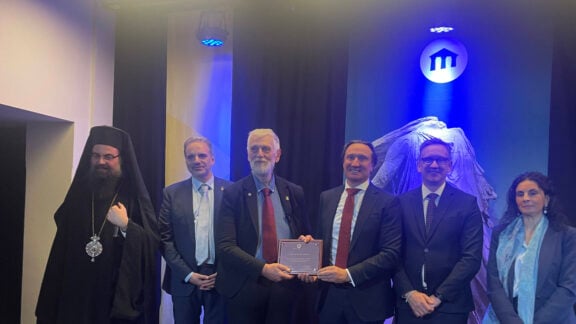I cannot miss the edifice in the photograph accompanying this article. It lies squarely within the path of my egress and regress to my home and I pass it frequently every day. In winter especially, when the rest of the faceless buildings of the suburb it dominates take on an ashen hue and seek to sink down into the depths of the earth, there to hibernate until such time as the gleaming light of summer can render it blindingly luminous, it stands as a symbol and a portent of the warmer weather to come.
It is in the summer, however, that this house comes into its own. The seemingly incongruous, when compared with the drab brickwork or dark render of the recently-constructed homes around it, whitewashed walls, against the blue eaves and the terracotta tiles, all serve to temper the harsh Australian sun into something more palatable and intelligible. Where the Australian summer at its height seeks to reject or menace human habitation, here in Melbourne’s north-west, far from the sea, this house reconciles nature and mankind, in a way that only those who have sailed the Aegean Sea can truly understand to any depth. It therefore serves as a seductive siren song for the beauty of a land whose lure is irresistible.
I know this, for every time I drive past, I am assailed by the siren’s song, which beguiles all of my senses, even the olfactory. Through the sealed cubicle of my mode of conveyance, which serves to isolate me from my surroundings, I see the mural of the sultry island streets skilfully depicted upon the studio doors, languidly beckoning. I can detect a hint of lavender and thyme. I can actually smell the salt on the breeze. I feel, instead of the brake and the accelerator, the crunch of beach pebbles against my feet and I arrive home, nostalgic for a postcard home that is not my own, renewed, but also, inexplicably disgruntled, muttering the following lyrics from Kostas Karalis, old song: ‘Αν είσαι μια βραδινή βροχή στη θάλασσα/ αν είσαι ένας βαπορίσιος καπνός στο πέλαγος/ αν είσαι ένα παλιό εικόνισμα/ σε μια εκκλησιά/ πού θες να το ξέρω’, intermingled with sundry Yiannis Parios Greek island song lyrics under my breath. Soon after, I begin to ponder why the introduction to Karalis’ song appears to be exactly the same as that of the Sugarhill Gang’s Apache, and my yearning recedes gradually and imperceptibly, but never manages to go away entirely.
This house has a name of significance: Ἑλένη. This name is emblazoned in blue upon the property in blue polytonic Greek, not the modern monotonic variety, as if to denote the polymorphy of the house and the manner it is able to straddle a cross-cultural divide The aspirant before the E, at least in my opinion, denotes passion, as if one must pant, if one is to properly pronounce the name. More than a name, it is a manifesto, for it undoubtedly serves as a strident feminisation of its ethnic identity – it is Hellenic, and there can be no dispute about this, for everything about it, from the terracotta pots to the ancient shields on the walls, proclaims it to be so. In the area, one can find countless number plates denoting a Hellenic place of origin, or even, zoomorphic tendencies (hence ‘AETOS’ and the Pontian ‘POULIM’) however, apart from one other property, that bears the name of the Northern Epirot village Kosovitsa, I know not of any other property that so blatantly makes a statement as to its Greek affiliations, and its homage to its ancestry, for the owner has named it in honour of his mother.
This is surprising because our municipal area has enjoyed a sizeable concentration of Greeks since the fifties. In contrast to other municipalities, where Greeks rejoice in large numbers, our Greeks are not ‘in your face’. Save for two churches, and John Rerakis’ most brilliant Philhellene Restaurant, there exist no facilities or areas where they congregate, no way of distinguishing them from the rest of the populace, save for the tell-tale signs of olive trees planted on the nature strip or barely discernible notices warning Jehovah’s Witnesses away from their doorsteps and Palm Sunday crosses and bay-leafs tucked carefully within the lattice of the security door. Miss these subtle clues and you could be forgiven for thinking that the Greek presence within the municipality of Moonee Valley was negligible. This property therefore, with its unmistakable blue and white colour scheme, and its remarkable appropriation of the suburban landscape, serves as a clear, unequivocal rallying point and cultural sign-post for all those venturing within and without the municipal bounds: Here (at least) reside the Hellenes, fearlessly, wearing their hearts upon their Lacedaemonian shields, and we can all pridefully crank up the Greek music in our cars as we drive by.
From what I have been given to understand, the responses to this architectural poem and beacon of diversity have not always been the most benign. Apparently, some local residents have not taken kindly to the translation of Greek island architecture to suburban Melbourne and, on three separate occasions, have made complaints to the local council, requesting that they investigate alleged building code violations. Furthermore, it is alleged that the ingenious home-owner has been subjected periodically to anonymous hate-mail inspired solely by the appearance of their magnificent construction. The story goes that on the third time the council building inspector visited the property, it became apparent to him that the complaints received were motivated primarily by racism and thus, refused to investigate further, indicating that while there is a price for seeking to assert one’s identity through architecture, ultimately, purity of intention may ultimately result in justification.
At a time when the architecture of Melbourne is increasingly becoming dominated by faceless and anaesthetic box-like constructions that exude unfriendliness and a desire for non-communication, this home, the work of a true artist, exudes the exact opposite: an extroverted desire to communicate, to assert personality and welcome the passerby. In short, it has character, and as such it is an invaluable asset to the municipality in which it proudly erects itself.
It is also forms an extremely important part of our own social history, and it is high time that studies of the way we express our ethnic identity through architecture cross-generationally are undertaken, before assimilation of taste and mainstream pressures, similar to that apparently experienced by the owners of this remarkable abode, inevitably impose upon us a drab conformity that completely silences our sirens and replaces our constructive exuberance.
*Dean Kalymniou is a Melbourne solicitor and freelance writer.








